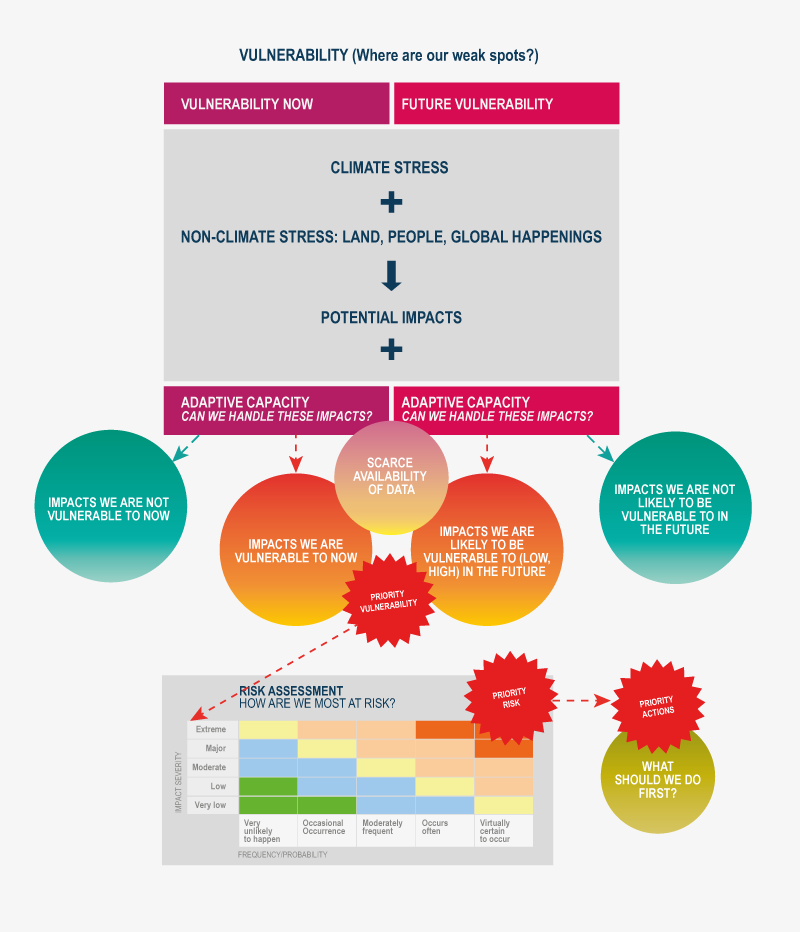
ACT Project Guidelines for local adaptation strategies
METHODOLOGY DEVELOPED AND PATH ASSESSMENT
ISPRA managed the methodological coordination required by the Action 3 - Local Impact Assessment, in order to ensure a common approach and a shared method for the assessment of impacts and vulnerabilities for the three partner cities.
The diagram shows the methodology adopted on the basis of a thorough review of the existing literature (see the State of the Art review on Adaptation).
The methodology used required the elaboration of climate scenarios to the year 2100 for the main climatic variables (see the Climate trends and projections) and the development of a set of indicators for the different components of vulnerability. The impact analysis was performed using methods and models which allowed to quantify the future effects of climate change on natural areas and socio-economic systems considered (see the Climate change impact assessment and local vulnerability).
Vulnerability and risk were then combined in order to identify the priority actions. In cases where it was not possible to perform a quantitative analysis, a qualitative approach was adopted through experts involvement.

THE ROADMAP FOR LOCAL ADAPTATION PLANS
In the context of the Action 3 ISPRA realized the Roadmap for the development of Local Adaptation Plans to climate change (LAPs).
The Roadmap is based on the results of previous actions, which have provided relevant scientific evidence on climate change scenarios in the three studied areas and represents the linking document between the impact assessments carried out for each local municipality and the Local Adaptation Plans.
The Roadmap is aimed to support the needs of start-up and the subsequent process towards the adoption of adaptation plans at the local level, involves the definition of the most vulnerable sectors on which the Plans will be focused, identifies the approach and strategic guidelines to be adopted at the local level, provides useful recommendations for the implementation of an effective adaptation process.
The Roadmap therefore identifies 8 categories of actions:
1. ensuring political support;
2. building technical and managerial commitment;
3. planning;
4. planning the implementation;
5. planning monitoring, evaluation and review;
6. engaging stakeholders;
7. integrating adaptation into sectoral policies and programs;
8. communicating and disseminating.
Finally the paper proposes some general recommendations, based on the shared principles of good adaptation, and specific suggestions for local governments responsible for the preparation of Plans.
THE GUIDELINES FOR THE LOCAL ADAPTATION PLANS
The Guidelines for the Local Adaptation Plans are the result of the activity carried out within the Action 7 – Evaluation of project results of the LIFE ACT. The document has been elaborated by the Institute for Environmental Protection and Research (ISPRA, Italy), in cooperation with the local partners of the project.
While climate change is commonly perceived as a global issue, leading to the increase in the global temperature, its effects emerge locally thus affecting local environmental resources, economic activities, and social aspects. Adaptation in natural or human systems in response to actual or expected climatic stimuli or their effects, which moderates harm or exploits beneficial opportunities (IPCC), is therefore needed at all levels of administration, and cities are central in this context.
The purpose of the Guidelines is to provide practical and operational support to public administrations that are interested in starting a process towards adaptation to climate change, and in particular to the local authorities located in the Mediterranean area where similar vulnerabilities - with respect to those identified in the areas investigated during the project - might be experienced. The approach proposed is not intended to provide prescriptive format to users - there is no one approach that best suits all - but it rather aims at providing to local administrators basic theoretical concepts on key climate adaptation issues as well as offering examples of successful experiences gained within the project.
The structure of the Guidelines has been drawn on the basis of the main common elements of the adaptation policy cycle, with particular attention to the Adaptation Support Tool provided by the Climate-Adapt Platform. The following steps are described:
Step 1: Get started. Organizational and technical management and political commitment are two key features of the initial step. Furthermore, an initial identification of the financial resources required should be useful at this step.
Step 2: Review the available knowledge and establish a baseline. The collection of available information about climate and its impacts is a fundamental step for adaptation to climate change and for the creation of a reference scenario. Learning from other experiences, while trying at the same time to avoid the mistakes previously committed, helps making climate change adaptation successful.
Step 3: Assess vulnerability and risk. The assessment of vulnerability and risk is based on the available information collected and aims at identifying priorities for adaptation as well as knowledge gaps and needs.
Step 4: Plan. Based on the priorities previously identified, objectives and targets should be established. Therefore, a portfolio of adaptation options is created and the best measures selected based on specific criteria.
Step 5: Implement. At this step is fundamental to identify the responsibility for implementation and define the implementation tools, the financial resources and the drivers and constraints for implementation.
Step 6: Monitor, evaluate and update. The progress on adaptation is regularly monitored and evaluated through appropriate indicators. An update of the plan should be performed after a review of scientific assumptions.
During the whole adaptation policy cycle specific cross-cutting activities should be performed: involvement of stakeholders, mainstreaming of adaptation, communication and raising awareness.
For each step a specific chapter provides a box containing the key messages, some basic theoretical concepts that are useful for the understanding of the contents and practical examples.
Other news from the partners
With the contribution of the LIFE financial instrument of the European Community